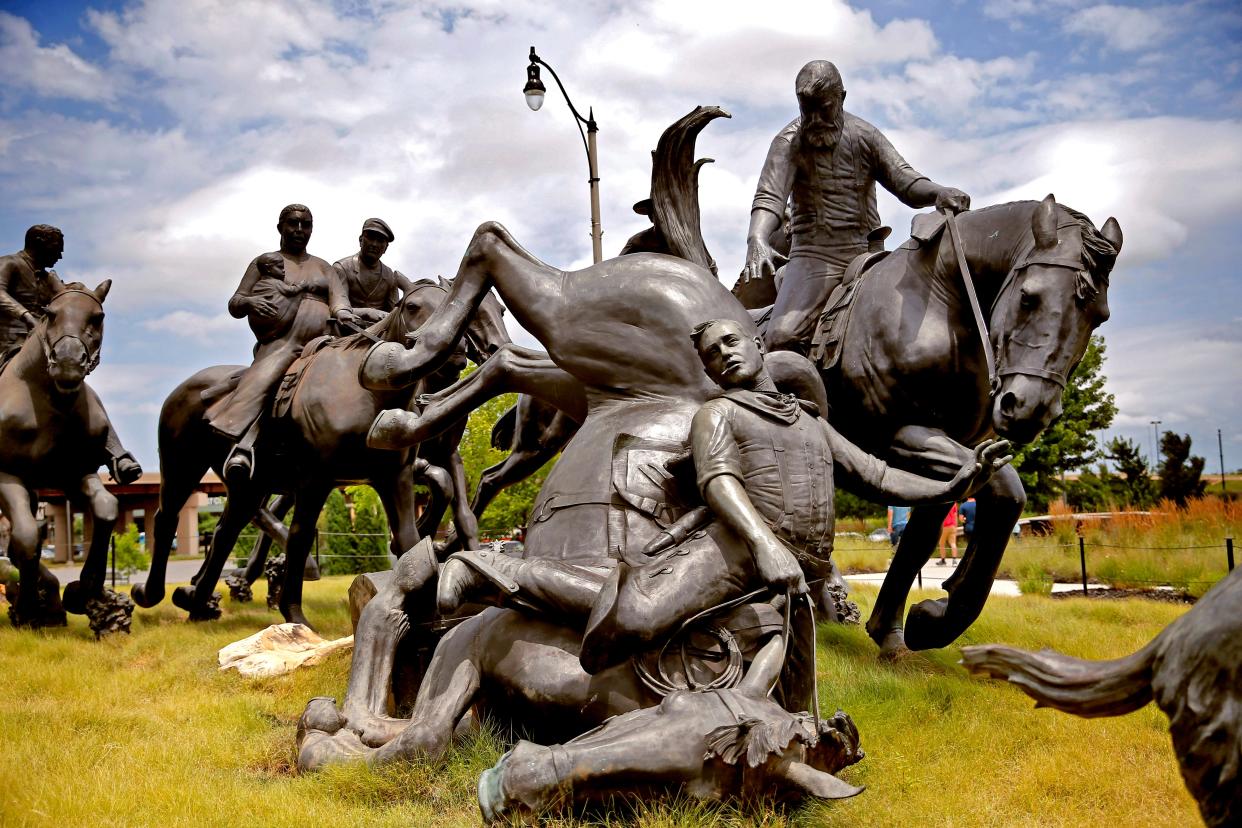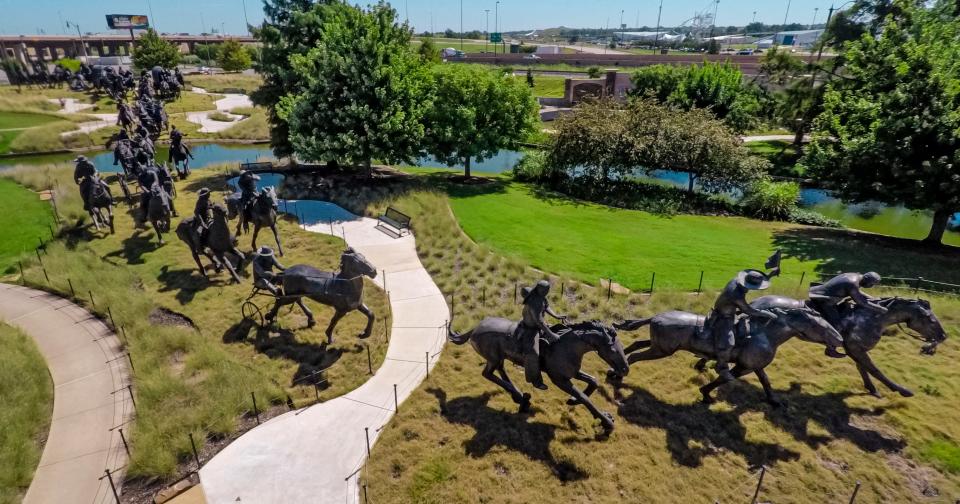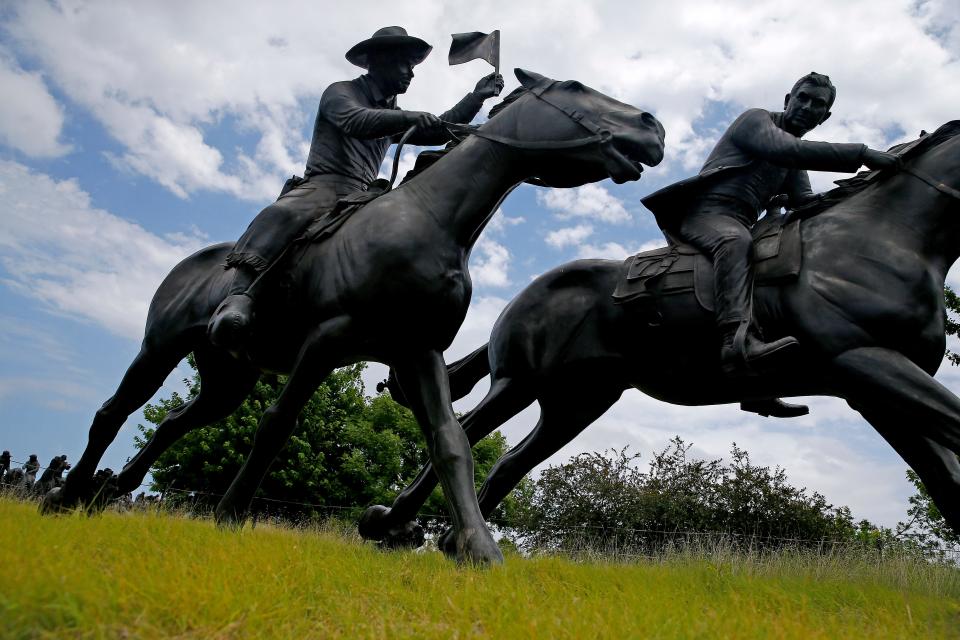City one step closer to including Indigenous perspectives in Bricktown Land Run monument

A push to include Indigenous perspectives alongside the Oklahoma Centennial Land Run monument is one step closer to fruition.
A report was presented to the Oklahoma City Arts Commission Monday with the conclusion the monument is one-sided and "hurtful" to Oklahoma's Indigenous communities. The report recommends the city request submission from artists for "a work of art-and-information" to provide visitors the chance to see the other side of the story.
Plans also include a "major art and cultural installation" in a later phase, according to city documents.
"This space and this report is extremely important for Indigenous representation," said Anita Fields, who helped compile the report. Fields is Osage and Muscogee. "Because there are very few landmarks, memorials or anything of that speaking to ... the true history of what happened during the land run," she said.
The 45 larger-than-life bronze statues — which stretch 365 feet and cross the southern end of the Bricktown Canal — have been the recipient of protest since 2007 when the Society to Protect Indigenous Rights and Indigenous Treaties (SPIRIT) formed to oppose centennial statehood celebrations.
The group again protested the monument and its heroic depiction of land run participants during the summer of 2020 and the racial reckoning which was bringing down monuments across the nation that honored people like Christopher Columbus and Confederate Army generals.
The group met with Oklahoma City Mayor David Holt, who rejected a proposal to tear down the monument completely but helped connect the group with late city arts liaison Robbie Kienzle. The city's Arts and Cultural Affairs office received a $5,000 grant from Oklahoma Humanities to hire Anita Fields and her son, Yatika Fields, who is Osage, Muscogee and Cherokee, to produce the report as knowledge keepers.
"It was very important to Robbie and, like she did with everything, she threw herself into it," said arts and cultural liaison Randy Marks, who took over the project when Kienzle became ill.
"It's been a real learning experience for me and it's one that I would like for virtually everybody in Oklahoma City to have," Marks said. "Because this is our heritage. The land run is our heritage, but this is our heritage also. This is the story of what has made Oklahoma and Oklahoma City, so it's important that it be told. And what better way for it to be told other than in art?"
Committee will form more specific plans for historical markers

Marks called the monument a well-done work of art that tells a "complicated story."
"This is the founding mythology of Oklahoma City," Marks said. "And by that I don't mean that it is not true. It's our founding story. This is the way that Oklahoma City was founded. The story didn't begin there, though. The story began some thousands and thousands of years ago with the people that first came to North America and inhabited the Great Plains, including Oklahoma, eventually."
In the last year and a half, a committee consisting of SPIRIT co-founder Brenda Golden (Muscogee), Matriarchs co-founder Kendra Wilson Clements (Choctaw) and Sarah Adams (Choctaw), and several city staffers worked with the Fields to obtain historical information and perspectives from Indigenous communities in Oklahoma.
Anita Fields said during Monday's meeting that she and Yatika had conversations and collected comments at pre-scheduled events within Indigenous communities.
Many of the responses they received said the historical context added to the monument grounds should be holistic, with information on the tribes that have always called Oklahoma their home, the tribes that were forcibly removed here, how the land run impacted them then and still does today.

"For the settlers, this was an exhilarating event because they were choosing land that would allow them to create roots for generations to come," the report said. "This was at the expense of Native people who have experienced generational trauma from Land Run events."
Marks said the next step is to, likely through a larger committee, determine what exactly the city would like to see in terms of historical markers at the monument site. He said he didn't have an exact idea of when this could be completed.
"We don't want to rush it and we don't want to delay it," Marks said. "And we don't know what the right time is going to be. So we're going to start working on it, and take it step by step and get there expeditiously, and hopefully at the right time."
Report is just starting conversation, arts commissioner says

The Oklahoma City Arts Commission voted unanimously to receive the report and to recommend a call to artists be formed, which would ultimately be sent to city council for approval.
Commissioner Terri Cooper expressed concern that the process seemed rushed and that the commission needed more time to digest the report.
Commissioner D.G. Smalling said receiving the report is just the beginning of the conversation.
"There has to be acceptance that we don't know where this is going and that's fine," Smalling said. "I'll just speak from my own from southeastern perspective and Choctaw perspective, the conversation is what's important ... we're offering dialogue where dialogue was never offered."
'It is time for us to have our perspective put there'
Oklahoma artist Paul Moore, who is Muscogee, was commissioned in 2001 to begin creating the sculptures. Several were done in time for the 2007 centennial but the last figure was not installed until 2019.
Moore has declined to talk to The Oklahoman for previous stories on the monument. Moore told The Oklahoman in April that he “has had so many things written about (him) by the press that just isn’t right,” and that because of these past “misleading news stories,” he has been unwilling to speak to the media for many years.
The report presented Monday points out that telling the Indigenous history of Oklahoma is "severely lacking" in public schools, monuments and state parks.
Golden and SPIRIT have protested land run re-enactments in public schools, where elementary students dress up as pioneers ready to stake their claim of free acreages in the so-called Unassigned Lands.
"In fact, the land wasn't free," Golden said at Monday's meeting. "Because my people marched here, six out of 10 of them died on the way here, under a false premise that once we got here, our lands would never be disturbed again ... It is time for us to have our perspective put there, our part of history."
The group has taken the same approach towards the city regarding the monument that it has to asking schools to end these events, she said.
This article originally appeared on Oklahoman: Report: OKC Land Run monument is 'hurtful' to indigenous communities

